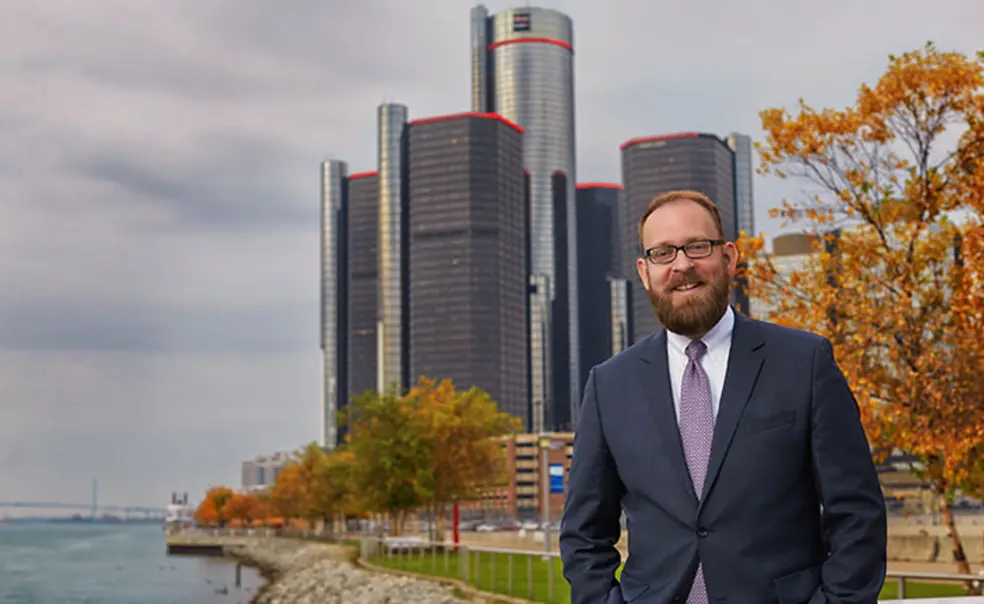Mark Wallace ’99 Creates Community Spaces at Detroit Riverfront Conservancy
“I always loved what the riverfront means to our city”
It was in Elizabeth Bogan’s economics class at Princeton where Mark Wallace ’99 realized the significant economic inequalities that exist in the United States. That realization inspired Wallace to work in Detroit, which is undergoing a renaissance.
Initially, Wallace — who has been CEO of the Detroit Riverfront Conservancy since 2015 — taught in the Detroit Public Schools from 1999-02.
“When I came to Detroit, my first opportunity to experience the city professionally was as a high school teacher,” says Wallace, a Chelsea, Michigan, native who lives in Detroit’s Indian Village neighborhood. “That was a very impactful experience for me… . I saw firsthand the challenges inner-city schools are facing.”
In 2004, Wallace graduated from the University of Michigan’s Gerald R. Ford School of Public Policy in Ann Arbor. He aspired to work in educational policy, but Detroit was headed towards bankruptcy and the economy was in a recession.
Still interested in helping Detroit realize its potential, but unable to find a position working in educational policy, Wallace took a position with a real estate development firm Hines Interests, LP. In his 10 years there, his biggest projects included Chicago’s River Point development, a 50-story tower on the Chicago River featuring a 1.5-acre public park. Wallace also led the efforts to bring insurance giant Blue Cross Blue Shield of Michigan to the GM Renaissance Center in Detroit.
“That was a really complicated transaction,” he says. “It took us a year to get that lease done. At the time, that was the biggest deal anybody had done in Detroit in a decade.”
While in real estate, Wallace worked on the Detroit International Riverfront, which spans more than three miles from Cullen Plaza to Gabriel Richard Park. Once opened, the Detroit Riverfront became one of the region’s most popular places to walk, run, bike, splash around in the fountains, ride the carousel, enjoy the nature areas, or relax at the RiverWalk Café.
“I always loved what the riverfront means to our city,” says Wallace. “Detroit contains a very large geography and does not have a significant residential density. Because of those conditions, we don’t have a lot of places where people come together in the city. What I realized over the course of my real estate career is the most exciting place in any big city is typically where people from different backgrounds come together. A lot of times, that will be farmer’s markets or public parks. In Detroit’s case, it’s the RiverWalk.”
The RiverWalk draws about 3 million visitors annually, from diverse backgrounds, Wallace says. And the Detroit Riverfront Conservancy has been at the vanguard of community engagement. The Conservancy is in the process of building a 22-acre waterfront site called the Ralph C. Wilson, Jr. Centennial Park. It has received a $50 million grant from the Ralph C. Wilson, Jr. Foundation to support this park, scheduled to open in 2022.
The Conservancy is very intentional about asking Detroiters for their input in the project. In addition to holding a design competition, it included a group of community members who toured parks in Chicago, Philadelphia, and New York.
“When we assembled these community members, we did not choose people who always show up to community meetings, we didn’t choose politically-connected people, we didn’t choose well-meaning donors — we chose Detroit residents,” Wallace says. “We had senior citizens, a high school student, and several moms who traveled with their kids. We want to build this park for the city, not the powerful members of the community. I’m really proud of that process, which has been really impactful and guiding.”
Slated to open in July on the East Riverfront is a new beach-themed play area and floating bar called the Robert C. Valade Park (named for late Carhartt CEO). The park has a large beach, an enormous sandbox for kids, a community grill/picnic area, two restaurants, a bar, and food truck.
“The public has really fallen in love with the park. We’re really excited about it,” says Wallace. “The places that we’re creating are going to be important to our community for years to come. That’s the really exciting part of this work. When you build a park, you know that it will be a place where kids can come, where kids beg their parents to bring them, and it’s going to be place where people make memories that will last a lifetime — that’s the best part of my job.”












No responses yet